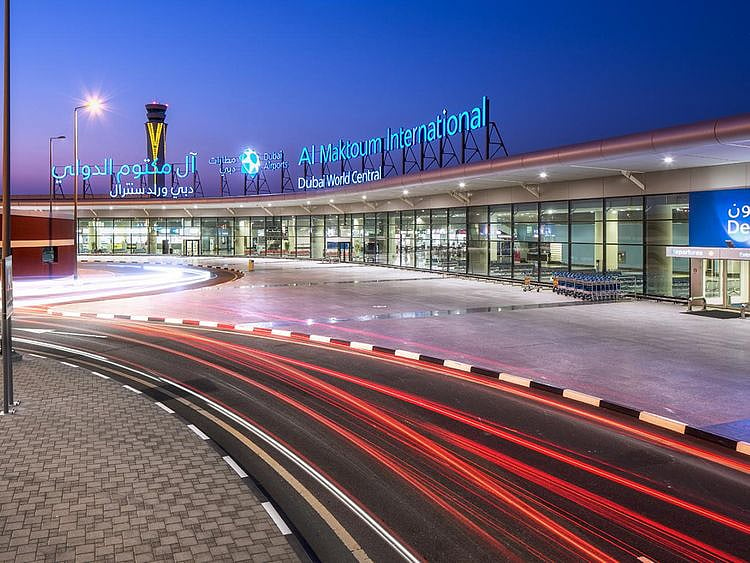DWC, Dubai's $35 billion airport set to become the new mega-hub
DWC poised to become the largest airport, envisioned to take over DXB operations by 2032

Al Maktoum International Airport, also known as Dubai World Central (DWC-AMIA), stands as a testament to Dubai's ability to dream big — and create the future.
This $35-billion mega hub marks the emirates' bold vision for its outsized place in global aviation.
The move is part of Dubai’s grand strategy — not just to stand among global aviation powerhouses like London, New York, and Tokyo with their multiple airports, but to soar beyond them, sharpening its competitive edge even further.
Here's all you need to know about the project:
Capacity, runways
Designed to accommodate up to 260 million passengers annually, the airport will feature five parallel runways and 400 aircraft gates, making it one of the most technologically advanced aviation hubs globally.
Largest greenfield airport and aerospace cluster
As the world's largest greenfield airport and aerospace cluster project, DWC-AMIA is set to revolutionise air travel with a sprawling land area of approximately 70 square kilometers — around five times the size of the existing Dubai International Airport (DXB).
Economic zone
With its strategic location in the Dubai South economic zone, DWC-AMIA is much more than an airport — it is a comprehensive aerospace city designed to support over a million residents and thousands of businesses, fundamentally shaping the urban and economic landscape of Dubai for generations to come.
It officially opened for passenger service in 2013, with cargo operations starting earlier in 2010. The airport currently supports cargo flights, executive flights, charter services, and some scheduled passenger operations.
Expansion plans
Short-term plans focus on increasing capacity progressively, with Phase Two expansion underway, including the construction of a new passenger terminal costing approximately $34.8 billion (Dh128 billion).
Shift in aviation
By 2032, Al Maktoum Airport is expected to take over major passenger operations from DXB, which will reach its maximum capacity of about 115 million passengers by 2031.
At that time, Al Maktoum is anticipated to handle around 124 million passengers, growing eventually to full capacity.
DWC-AMIA marks a significant shift in Dubai’s aviation landscape.
The numbers are staggering:
124 million passengers by 2031
260 million passengers: annual capacity of DWC
Five parallel runways
400 aircraft gates (once fully completed).
By 2032, Al Maktoum Airport is expected to take over major passenger operations from Dubai International Airport (DXB), which will reach its maximum capacity of about 115 million passengers by 2031.
Passenger capacity and expansion plans
The airport is being developed to become the world's largest in terms of passenger capacity, ultimately aiming to accommodate up to 260 million passengers annually.
Short-term plans focus on increasing capacity progressively, with Phase Two expansion underway as of 2024, including the construction of a new passenger terminal costing approximately $34.8 billion (Dh128 billion).
By 2032, Al Maktoum Airport is expected to take over major passenger operations from Dubai International Airport (DXB), which will reach its maximum capacity of about 115 million passengers by 2031.
At that time, Al Maktoum is anticipated to handle around 124 million passengers, growing eventually to full capacity.
The airport will feature five parallel runways and 400 aircraft gates once fully completed.
Location
Situated in Dubai South, an economic zone designed to foster residential and commercial development alongside the airport.
The airport spans an area of approximately 70 square kilometers, making it roughly five times larger than Dubai International Airport.
Long-term vision
The project reflects Dubai’s ambition to create a next-generation, state-of-the-art global aviation hub integrating AI-enhanced traveller experiences and sustainable energy solutions.
It aims to position Dubai as a major international hub for travel, luxury tourism, and foreign investment, reducing economic reliance on oil revenues.
Flydubai is expected to be among the first airlines to relocate operations to Al Maktoum as DXB reaches capacity.
Sign up for the Daily Briefing
Get the latest news and updates straight to your inbox
Network Links
GN StoreDownload our app
© Al Nisr Publishing LLC 2025. All rights reserved.